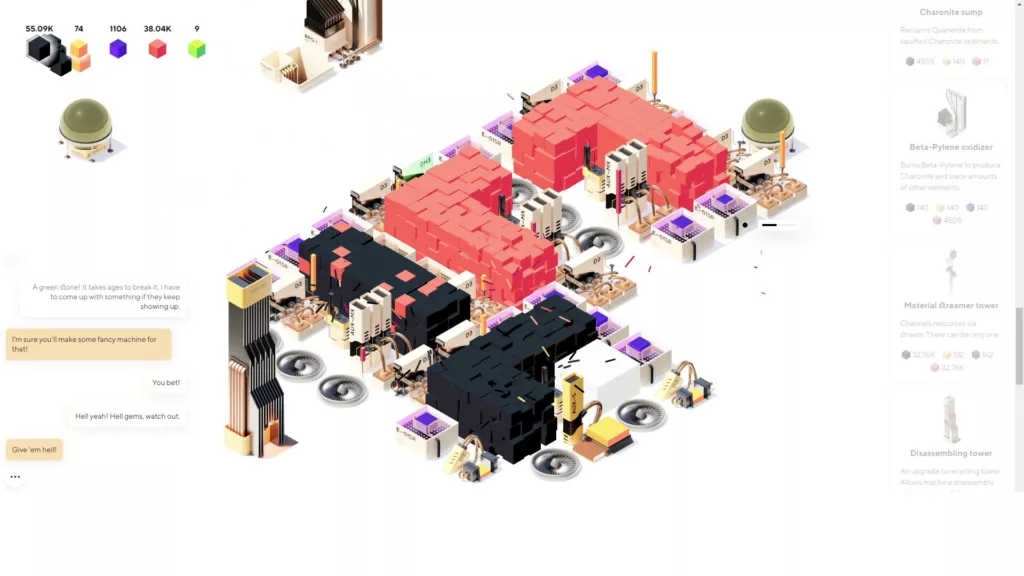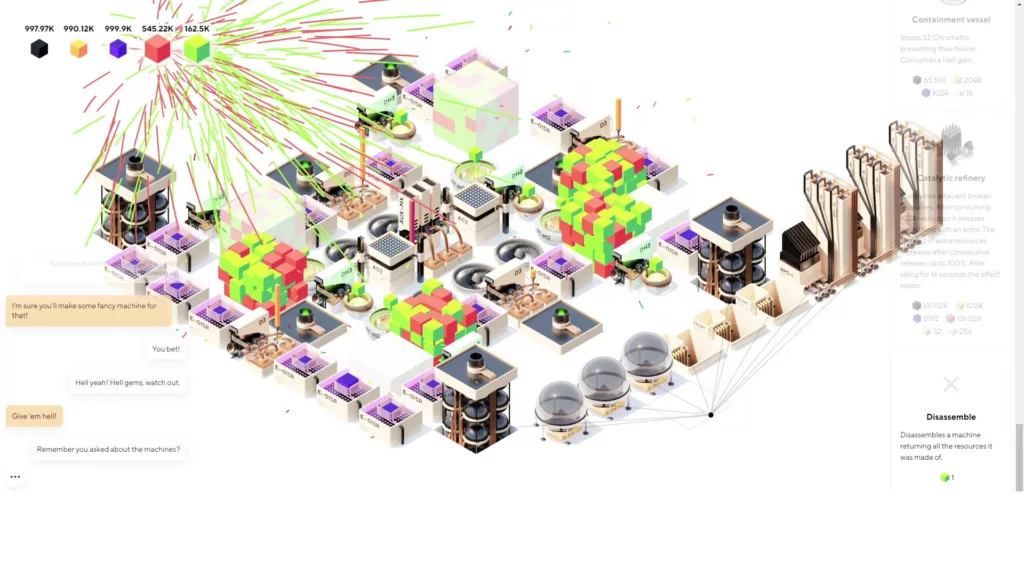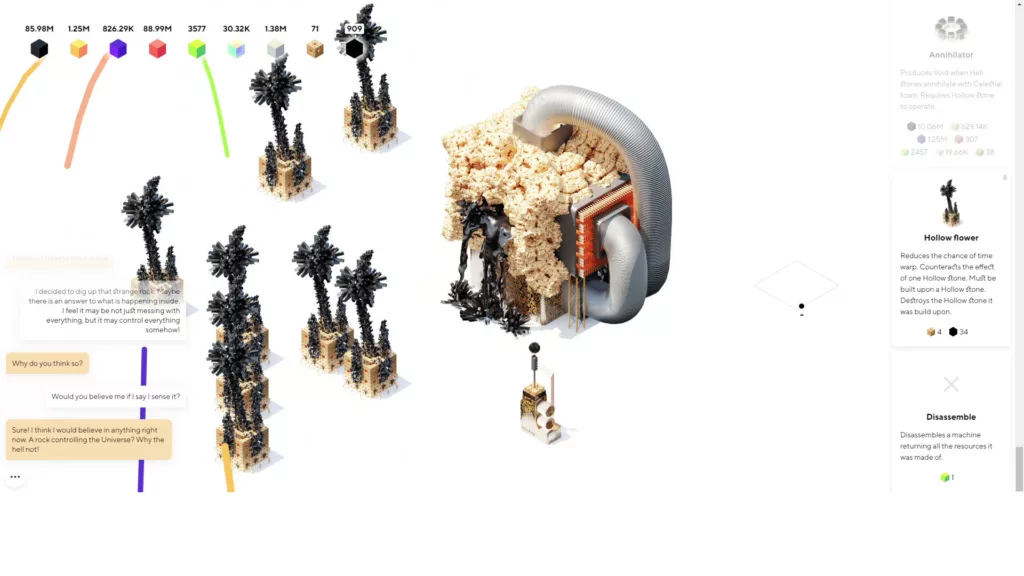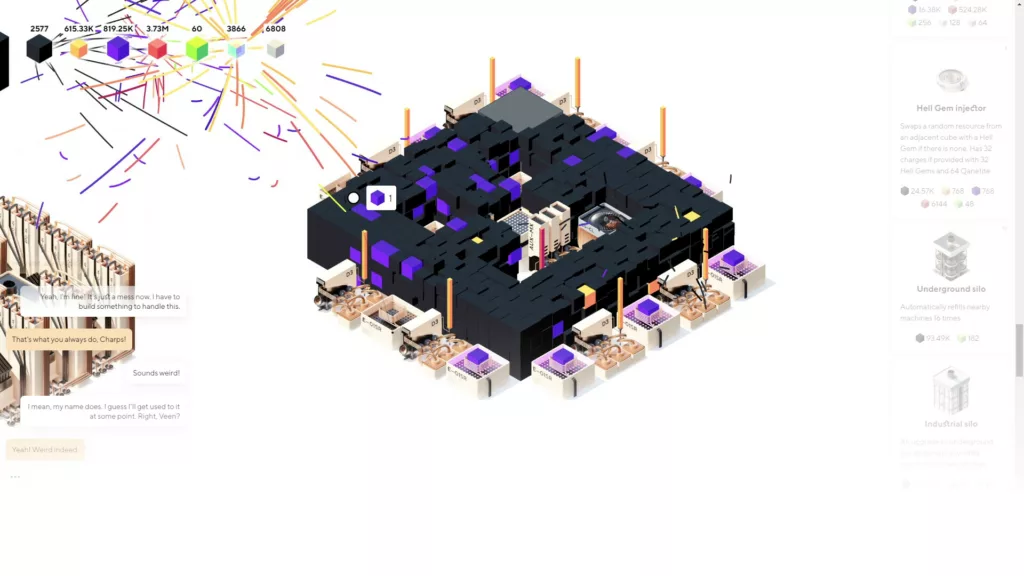Sixty Four is an addictive “idle” game from developer Oleg Danilov that will having you digging deep to build an automated block factory. If you’re not familiar with the genre, idle games involve simple, repetitive actions that gradually unlock more automated processes. They’re all about kicking back and watching the numbers tick up.
In Sixty Four, you start by clicking an “extractor” machine to make giant blocks pop up around it. Smash those cubes apart for resources to build more machines. Before long, you’ll have pumps pulling up blocks automatically and resonators breaking them down without you lifting a finger. Pretty soon, your clean white void is a sprawling, efficient factory with different colored blocks zooming around to power different machines.
It’s a super straightforward premise focused on layout strategy and production chains. But the crisp, modern visuals definitely dress up the genre’s usual focus on watching bars slowly fill. And there’s even a bit of mystery too in the minimal story about wondering how you got stuck in this void. The core loop may get tedious for some, but fans of optimization and automation will dig what Sixty Four is mining.
So let’s dive in and dissect where this stylish idle game really shines…and where it still leaves you longing for more.
A Feast for the Eyes, Not the Ears
One area where Sixty Four clearly stands out from the idle clicker pack is its sleek, stylish visual presentation. This is an extremely sharp-looking game, with its modern, cubist aesthetic and crisp lighting effects.
The blocky machines you construct look like they were designed by Apple – all smooth white panels and glowing blue lights rather than the usual clunky conveyors and smokestacks of factory games. And your growing labyrinth of extractors and resonators pulses with visual energy, as streams of colored blocks zoom around the clean backdrop. Sometimes form matches function in gaming – looking organized feels satisfying when you’re focused on efficiency.
It’s easy to get lost staring into the hypnotic dance of materials flowing through your prosperous automated empire. Sixty Four takes the clinical aesthetic of the idle genre and makes it feel downright artsy.
That artsy theme even extends to the sound effects, with metallic clanks and hydraulic whooshes bringing your factory to life. But sadly, all that visual imagination didn’t extend to the music. There are no background tracks at all in Sixty Four – just the constant ambient noise of your machines. A few upbeat, electronic mixes could have made the experience feel more engaging rather than just strangely empty.
So while Sixty Four definitely stands out visually from the standardized idle template, a complimentary soundtrack could have completed the sensory package. As is, it feels a bit like touring an art museum with earplugs in. The lack of audio variety starts to grate after awhile, even when there’s plenty of eye candy to soak up.
Digging Deep
The core gameplay loop of Sixty Four revolves around mining colored blocks from an Extractor and breaking them down for resources. It starts simple: you manually activate the Extractor, then click the extracted blocks to crush them into raw materials. Before long though, you’ll be buying tools to automate those drudgeries.
The early machines you unlock keep the Extractor running automatically, while more advanced tools like Resonators break blocks the moment they appear so you don’t have to click. As your tech tree expands, the basic loop becomes more and more automated. Instead of smashing blocks, you’re planning the most efficient layouts for your new machines to keep production humming.
This increasing complexity is the real challenge of Sixty Four. New block types get introduced frequently, each powering key buildings in your growing factory. So you’re constantly rejigging machine positions to keep their input flowing. It goes from a clicking game to almost a puzzler, as you rearrange everything to eke out slightly faster material conversion.
That puzzle aspect makes Sixty Four way more active than your average idle game, where you mostly just watch numbers tick up. Here there’s real strategy in balancing all the materials needed to upgrade further. You’ll be moving drills around to uncover new block seams, rerouting conveyors, rebuilding entirely to make space. It keeps you engaged in the nuts and bolts of running your bizarre, glowing empire.
But that complexity curve also leads to the game’s biggest issue: there’s no guidance on what to focus on next. New blocks get randomly uncovered, so you never know which upgrade path to pursue in advance. Without any tips or milestones, progress becomes aimless. You’re left to inefficiently stumble onto the next big invention, hoping it’s the right color blocks you just stockpiled.
So while the expanding production line complexity adds fun strategic depth, not having any goals or priorities makes it feel pretty directionless. Still, fans of open-ended factory building and supply chain puzzles will enjoy the freedom to plumb the depths of their glowing block mines however they see fit.
Moving Forward…Blindly
As your otherworldly factory expands, you’ll unlock new machines for automating processes, more valuable cube types to harness, and puzzle piece-like buildings that upgrade specific parts of your operation. Figuring out how to fit all those pieces together lets you seriously ratchet up production. When everything is rolling, you feel like a genuine wizard-CEO.
But while new systems add satisfying complexity for would-be factory tycoons, actually progressing from one upgrade to the next is messy in Sixty Four. The game is incredibly cagey about what you should be working towards at any given point. You never know what resources or buildings are required to progress next – it’s a total crapshoot.
That leads to lots of inefficient dead ends as you stockpile one material type only to find out you needed another color altogether. Without any guidance on the next milestone, you waste tons of time heading down the wrong crafting branches. Some simple cues about which blocks will unlock the next key machine would go a long way.
The lack of feedback extends to optimization too. You can’t see how adjusted layouts impact your overall material conversion rates. And with no way to snapshot save builds, experimentation is costly. If you end up with less efficiency, you can’t roll back without rebuilding from scratch. There’s no sandbox to test new arrangements either, so progress happens very incrementally.
It’s unfortunate because the complex production chains beg for number crunching and strategic optimization. But the tools just aren’t there to readily iterate and improve your factory. It often feels like you’re fumbling around in the dark hoping to randomly strike the next motherlode. For the studious factory moguls among us, providing some illuminating feedback would remove a lot of the aimless grind.
Still, for players who enjoy exploring expansive crafting systems at their own pace, the unpredictable spikes in progression can make for a less linear experience. Just expect your share of headaches from wasted resources too as you gradually piece this puzzle together through stubborn trial-and-error.
A Mystery Wrapped in an Enigma
For a game focused on building ever-larger resource conversion contraptions, Sixty Four contains a surprising amount of environmental storytelling. The stark white void you mine your neon blocks in feels oddly ominous. And the way you got stuck here operating this bizarre factory is teasingly unclear.
The narrative mainly comes through cryptic text conversations displayed in the corner of the screen. It appears to be messages from a friend checking in on your increasingly strange reports about being trapped in an empty dimension with self-replicating machines. Their concerned texts about filing a missing persons report underscore the bizarre reality you seem to be occupying.
This drip-feed of creepy flavor adds a layer of intrigue to the standard “watch numbers get bigger” idle formula. You start wondering how exactly you got implanted in this freaky block world and why you can’t leave. It’s a creepy Matrix feeling amplified by the sterile surroundings and digitized aesthetic.
But as artfully as Sixty Four weaves its central mystery, the story payoff is fairly minimal. Your friend’s messages mostly reiterate your confusion about this whole enterprise rather than revealing satisfying plot turns. And introducing much narrative at all to a fundamentally numbers-driven genre is questionable.
Still, the cryptic conversations do excel at creating an unsettling atmosphere that complements the game’s sense of detached, clinical progress. And they organically enhance the lingering feeling that optimizing this glowing labyrinth is maybe preventing you from addressing how and why you got here in the first place. So while the narrative impact is slight, it does infuse an incremental clicker with some human pathos and uncertainty. For a game about endlessly repeating the same actions, that dash of emotional flavor goes a long way.
Wrapping Up: Should You Mine These Blocks?
Sixty Four modernizes the factory management genre with some artsy style and additional layers of strategy. If you think watching conveyor belts move resources around sounds boring, this could get you invested through its uniquely hypnotic take on automation empire-building.
The crisp, ultra-modern visuals grab attention in such a clinical, numbers-driven genre. And unlocking new high-tech machines to help optimize your glow-in-the-dark block operation provides satisfying complexity for would-be logistics experts. It feels great guiding your mega-factory from humble pickaxe beginnings up to a monument of self-operating machinery.
That feeling of masterful automation is enhanced by the mysterious story backdrop too. Cryptic messages you receive add stylistic flavor and make you question the nature of this weird block reality you’re manipulating. It’s just atmospheric enough to feel distinctive.
However, that feeling of directed progress eventually hits a wall for most players. The utter lack of milestones or guidance around optimal upgrades leaves you bumbling down inefficient branches for way too long. It devolves into a grind as you wait for random chance to unlock the next step. And with no way to test arrangements or review rate information, optimization itself becomes guesswork.
So while Sixty Four modernizes the incremental clicker visual template, its gameplay can still feel pretty dated. Patience is mandatory as you decipher exactly what the endgame even consists of here. But for fans of the genre looking for a mysterious and stylish twist on number crunching, it might be worth taking a pickaxe to. Just be prepared for the grindy reality that incremental progress eventually sets in.
Sixty Four oozes atmosphere and introduces classic idle clicking to more thoughtful production line mechanics. But the aimless back half and lack of informative feedback dampen the fun considerably. Give this one a mining expedition if you enjoy parsing complex crafting systems, but keep expectations in check around seeing tangible progress from session to session.
The Review
Sixty Four
Sixty Four modernizes the idle game formula with some artsy visual panache but can't fully escape the genre's repetitive nature. Clever factory logistics provide initial fun, but a lack of structure around upgrades leads to frustrating aimlessness. The glossy aesthetics and production complexity offer something new to idle fans. But the core loop still trends repetitive after the initial sheen wears off. Mysterious story elements provide some motivation to uncover surprises but can feel disconnected from moment-to-moment play. With more helpful feedback guiding progression, Sixty Four could have reached greater heights. As is, it's a stylish incremental that probably won't change many minds about the pleasures of watching numbers tick slowly upwards. But genre devotees should still keep this one on their radar.
PROS
- Stylish and unique visual presentation
- Satisfying automation mechanics
- Additional strategy beyond typical idle games
- Mysterious narrative creates intrigue
CONS
- Lack of guidance around progression
- Frustrating aimlessness in mid-to-late game
- No milestones or goals to work towards
- Missing key optimization tools or testing features




















































